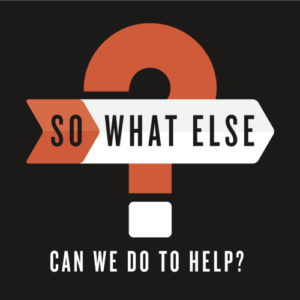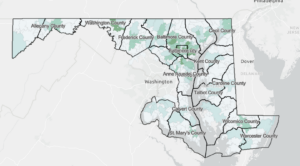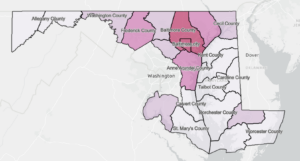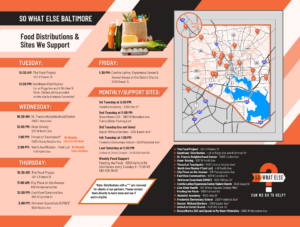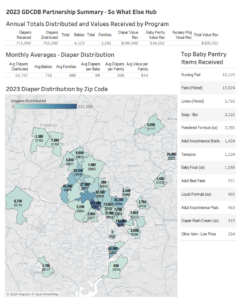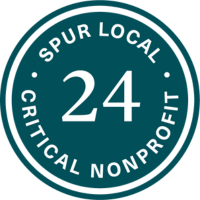Tackling Hunger in Baltimore City: The So What Else Baltimore Food Program
The So What Else Baltimore Food Program was born out of critical necessity. While hunger exists across the many DMV locations So What Else serves, Baltimore has been and continues to be one of the most deeply food-insecure regions in our program.
Twice as many households are food insecure in Baltimore when compared to the state of Maryland as a whole (St. Vincent De Paul Baltimore). While a significant amount of food resources and funding are allocated to Baltimore each year, it’s evident these resources have only put a dent in the city’s unmet needs, with the Maryland Food Bank’s Hunger Map reporting that over 49,350,000 pounds of food would be needed to entirely eradicate hunger in Baltimore (Maryland Food Bank). Just a glance at the Maryland Hunger Map, and it’s clear Baltimore and its surrounding counties suffer from some of the highest concentrations of hunger hotspots in the state.
To explain why Baltimore uniquely suffers from ongoing and pervasive hunger, we can look at the historical landscape the city is situated in. Baltimore was one of the first cities in America to institutionalize segregation, enacting a law to codify years of discriminatory practices in 1910. While eventually the law was overturned due to unconstitutionality, it was followed by a series of redlining practices by banks in the 1930s, which led to the subsequent divestment and underdevelopment of Baltimore’s predominantly black neighborhoods (Baltimore Hunger Project). Combined with blockbusting, and later, gentrification, these discriminatory policies are directly correlated with food insecurity, inequitable food access, and food desertification in Baltimore (National Low Income Housing Coalition). Compare any map of food insecurity in Baltimore with a map of historic redlining, and it’s clear that the two are intertwined.
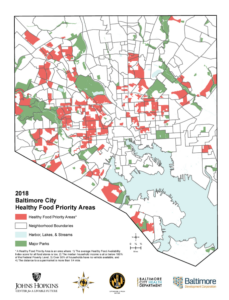
Map of current food deserts or “Healthy Food Priority Areas” in Baltimore City (Source: Baltimore City)
Today, 146,000 Baltimore residents reside inside a food desert, which is over a quarter of the population of the city as a whole (Baltimore Sun). However, some sources believe the percentage of residents affected by food deserts is much higher due to Baltimore’s car dependency and lack of public transportation. In a 2018 report, Morgan State University researchers found that as many as 42% of residents live in a food desert when vehicle access is considered (Morgan State University).
The onset of the COVID-19 pandemic further exacerbated the issue, resulting in an unprecedented increase in food insecurity from 18% to 21.7% as of 2021 (Baltimore City). In a city already suffering from systemic hunger, the aftermath of COVID was devastating. And while public health and economic conditions have improved in the years since, national inflation levels for grocery staples have only continued to worsen, with 2023 seeing a 4.3% increase in grocery prices from 2022, which saw an 11.4% increase in prices from the year before that (Baltimore Fishbowl). Yet despite these conditions, many local, state, and national food assistance programs, including the SNAP benefits program, have either seen major cutbacks or ended altogether, leaving vulnerable Baltimore residents to fend for themselves in the aftermath (Reuters).

So What Else Baltimore neighborhood food distribution during COVID lockdown in 2020
It’s within this context that the So What Else Baltimore Food Program was founded in 2020. In response to the COVID-19 pandemic and looming hunger crisis, So What Else Baltimore jumped into action, transitioning a small youth programming team into a food recovery and distribution network. Sourcing food from several businesses, including Sudanos, Trader Joes, Whole Foods, and more, the newly created Baltimore branch of the So What Else Emergency Hunger Relief Program developed a coalition of nonprofits, churches, and schools across the city to distribute millions of pounds of food.

So What Else Baltimore food distribution in front of City Place on the Avenue Apartments during 2020
By developing a largely mobile distribution model, So What Else Baltimore could bypass historic food and transportation deserts and deliver food to at-risk zip codes directly, bridging systemic access barriers. By rescuing edible food slated for landfills, whether due to company policy or excess supply, the team could keep the cost of sourcing that food low, allowing the program to rapidly scale up to meet the needs of the community.
Today, So What Else Baltimore hosts over 28 food distributions, community deliveries, and ad-hoc drop-offs in all four corners of Baltimore and beyond. On average, the team serves over 242,790 lbs of food a quarter to over 87,000 clients*, making So What Else one of the largest food providers in the city. While the program is primarily focused on serving West Baltimore, there are distribution locations in Hamilton, Highlandtown, Downtown, and beyond.
Food insecurity in Baltimore cannot be solved by any one organization alone. That’s why So What Else Baltimore’s success lies in collaborative hunger solutions with partnering organizations. It takes time to build community trust and client rapport, and by working with dozens of organizations that have a demonstrated need and years of community relationship-building, the team can quickly and equitably allocate resources to Baltimore residents.
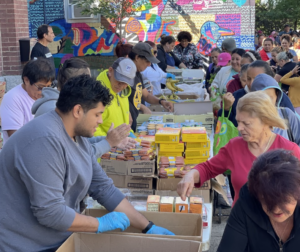
So What Else Baltimore distribution with Comité Latino de Baltimore, the Esperanza Center, and the Salem United Methodist Church in 2023
In addition to So What Else Baltimore’s Mobile Distribution Program, as of 2023, the chapter also opened their first brick-and-mortar pantry, located in the heart of southwest Baltimore, an area plagued by redlining and food desertification. Providing other household essentials, including clothing, furniture, diapers, hygiene kits, and more, the program has been a huge success since its opening.
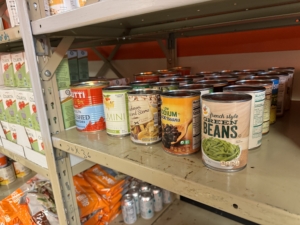
A community grab-and-go shelf at the So What Else Baltimore Resource Center
Despite these feats, there’s much left to be done in order to entirely eradicate hunger in Baltimore. While nonprofits like So What Else are making strides, the food insecurity crisis is vast and deeply embedded, the result of decades long policy decisions and social norms. Without increased government, business and community support, the status quo will likely continue.
Hunger isn’t always a glamorous or news-catching crisis, but it’s one with far-reaching effects for the people suffering from it. Join us in our battle to end food insecurity and food scarcity in Baltimore by supporting our organization today. All of us can make a difference if only we work together.
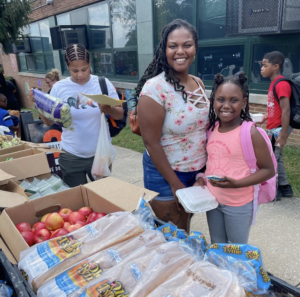
So What Else Baltimore clients receiving food during a “Back to School Night” event
To learn more about the Baltimore Food Program click here. To volunteer with So What Else Baltimore, sign-up here.
To make a donation to So What Else food programs click here.
Sources:
https://experience.arcgis.com/experience/fe4fdacfd20b46c08dac240ca8dd6192
https://www.baltimorehungerproject.org/blog/segregation-and-hunger-in-baltimore/
https://planning.baltimorecity.gov/baltimore-food-policy-initiative/food-environment
https://www.wmar2news.com/infocus/taking-a-closer-look-at-baltimores-map-past-and-present
https://www.morgan.edu/Documents/ACADEMIA/CENTERS/NTC/Chavis%20Final%20Post.pdf
https://www.reuters.com/world/us/us-food-benefits-poor-shrink-pandemic-provisions-end-2023-02-16/
*Note on So What Else metrics: quarterly data is calculated on a repeating basis. Many individual clients are recurring users, meaning the total number of unique individuals served is likely lower.
